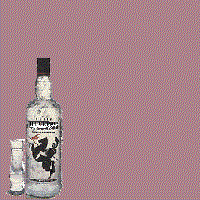Vodka, Polish and Russian
History, origins, tips
 My interest in vodka
began to develop while on an extended stay in Warsaw, Poland. At the time
I had a penchant for a night-cap of one part tequila to one part lime juice.
I was totally confounded in my attempts to purchase the ingredients for
my precious tipple. After peering over the shoulder of the licensee in
a Polish off-licence I purchased a bottle of Polish Wyborowa vodka
and nipped into the grocery store for a lemon. The result was a delicious
drink in its own right. I then began to look more closely at vodka and
it's origins.
My interest in vodka
began to develop while on an extended stay in Warsaw, Poland. At the time
I had a penchant for a night-cap of one part tequila to one part lime juice.
I was totally confounded in my attempts to purchase the ingredients for
my precious tipple. After peering over the shoulder of the licensee in
a Polish off-licence I purchased a bottle of Polish Wyborowa vodka
and nipped into the grocery store for a lemon. The result was a delicious
drink in its own right. I then began to look more closely at vodka and
it's origins. 
ORIGINS AND HISTORY
In Poland, as in other Slavic countries the word vodka is a diminutive
for the word water. It is available in a variety of fruit and spice infusions,as
well as in the unflavoured form.
I should mention that the Russians maintain that vodka was invented
in their country during the 1300's at the fort of Viataka. Most historians
agree that the Russians did originate their national drink but do not agree
on the date. There is evidence of a strong neutral spirit in Persia in
the 11th Century.
Of the unflavoured vodkas, the Slavs' skill in producing a highly
distilled neutral spirit inspired the idea of using such a spirit as a
basis for mixed drinks. Could this have been the origin for the cocktail?
The original purpose of the very strong spirit was that it would not readily
freeze in extremely cold weather. It was the same rationale which brought
the world's strongest commercially marketed liquor Polish Pure Spirit at
almost 80% proof.
The flavour of eastern vodka differs from the western version. The
aroma is described as strong, spirited, almost 'green' and possessing a
slight oiliness. A most superb example of flavoured vodka is Zubrowka.
This is sold with a blade of grass in every bottle. This 'bison grass'
is that favoured by the European bison which graze on the borders of Poland
and Russia. A vodka very rich in cherry flavour and colour is Wisniowka,
barely resembling vodka at all but nevertheless a powerful and delicious
drink.
Western versions of vodka are widely marketed, often with very Slavic
sounding names, such as Smirnoff, Vladivar, Borzoi. They have almost no
flavour and no colour. However, they are quite serviceable if all that
is required is a neutral alcoholic kick.
HOW TO SERVE VODKA
 Most of us have an image of
a fur-clad Russian tossing back glass after glass of the powerful drink
then smashing the glass in the fireplace. In fact, toasts like this were
usually limited to one. The glasses were so small that they held less than
an ounce. They were also specially made to break easily after drinking
a toast to the Czar. This guaranteed that the same glass could not be defiled
by toasting a lesser mortal.
Most of us have an image of
a fur-clad Russian tossing back glass after glass of the powerful drink
then smashing the glass in the fireplace. In fact, toasts like this were
usually limited to one. The glasses were so small that they held less than
an ounce. They were also specially made to break easily after drinking
a toast to the Czar. This guaranteed that the same glass could not be defiled
by toasting a lesser mortal.
Vodka is best poured from a bottle that has been well chilled in
a freezer. An attractive small glass with a long, slender stem does add
to the pleasure of drinking straight vodka. If want to be really elegant
fill a tiny glass with vodka then nest it in crushed ice in an Old Fashioned
Glass ( A straight tumbler).
You can sample my cocktail recipe for
Deep Siberian Blue.
Deb Clarke-Topper home page
You are visitor number to my site.
to my site.
Deb Clarke Topper
 email me!
Copyright © 1997 Deb Clarke Topper
This Home Page was created by WebEdit,Sunday,
January 12, 1997
Most recent revision Sunday,14 December, 1997
email me!
Copyright © 1997 Deb Clarke Topper
This Home Page was created by WebEdit,Sunday,
January 12, 1997
Most recent revision Sunday,14 December, 1997